 A hundred years ago, these dancers were getting their dance music courtesy of the airwaves. The image appeared on the cover of the July, 1924, issue of Radio Age.
A hundred years ago, these dancers were getting their dance music courtesy of the airwaves. The image appeared on the cover of the July, 1924, issue of Radio Age.

 A hundred years ago, these dancers were getting their dance music courtesy of the airwaves. The image appeared on the cover of the July, 1924, issue of Radio Age.
A hundred years ago, these dancers were getting their dance music courtesy of the airwaves. The image appeared on the cover of the July, 1924, issue of Radio Age.
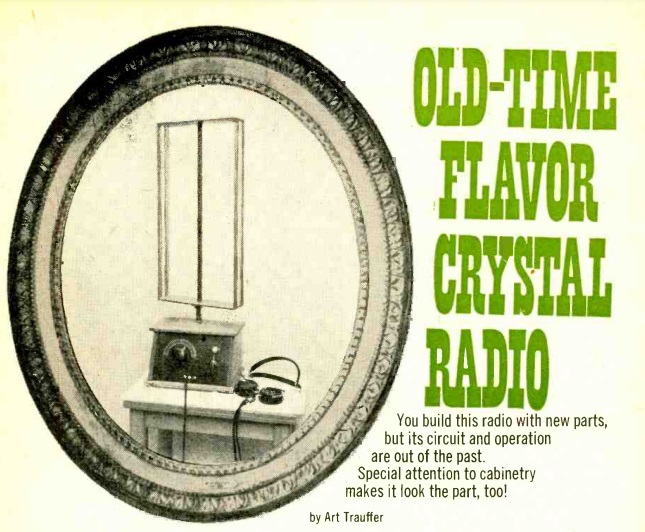 If you built this replica of an old-time radio when it was published, then today, it really is an old-time radio. The plans appeared in the July 1974 issue of Elementary Electronics for this crystal set. According to the magazine, the set is very selective, in part because it relies upon a loop antenna, which can be rotated to null out interfering stations. It requires no external antenna or ground, which also reduces static, and means that you don’t have to worry about lightning.
If you built this replica of an old-time radio when it was published, then today, it really is an old-time radio. The plans appeared in the July 1974 issue of Elementary Electronics for this crystal set. According to the magazine, the set is very selective, in part because it relies upon a loop antenna, which can be rotated to null out interfering stations. It requires no external antenna or ground, which also reduces static, and means that you don’t have to worry about lightning.
It had a galena crystal and cats whisker on front. But if you got tired of searching the crystal for the sweet spot, you could cheat by moving the headphone to a different socket, which was hooked up to a germanium diode hidden inside the cabinet.
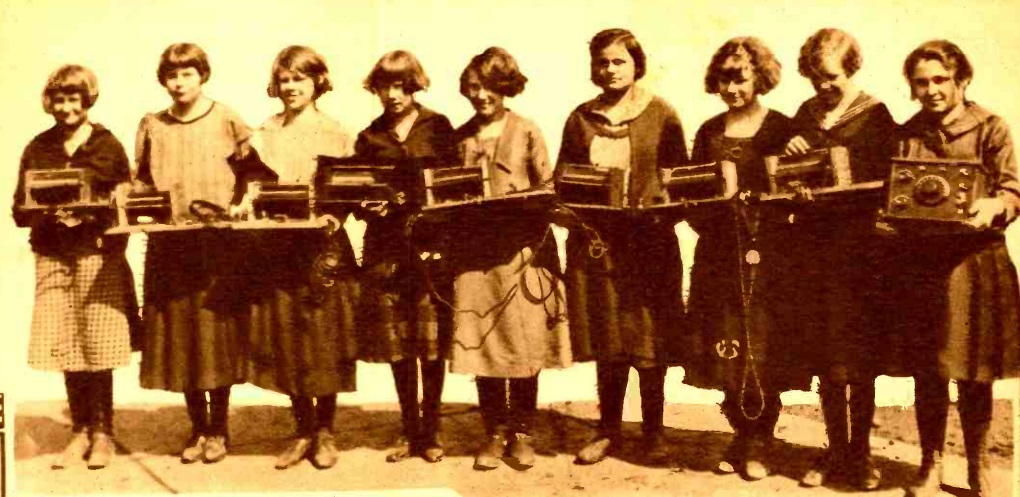 A hundred years ago, these girls, all students at a Chicago public school, are proudly holding the radios they made in a contest. The are shown in the July 1924 issue of Radio News, which noted that they would not let the boys outdo them. The showed superior workmanship and attracted the attention of local experts.
A hundred years ago, these girls, all students at a Chicago public school, are proudly holding the radios they made in a contest. The are shown in the July 1924 issue of Radio News, which noted that they would not let the boys outdo them. The showed superior workmanship and attracted the attention of local experts.
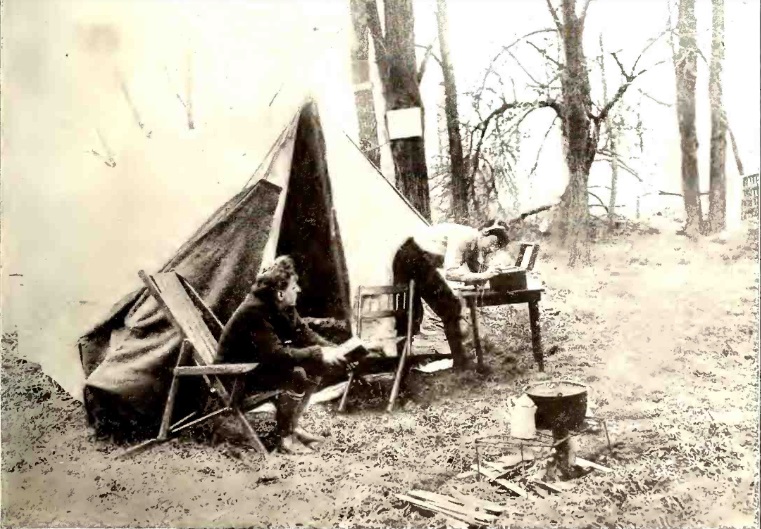 A hundred years ago, this father-son duo were entertaining themselves on an otherwise slow afternoon by tuning in a radio program in some distant city. They are pictured in the July, 1924, issue of Radio Age, which notes that no camping trip was complete without its radio equipment. No matter where you went, you couldn’t be so far as to not be able to pull in a broadcasting station.
A hundred years ago, this father-son duo were entertaining themselves on an otherwise slow afternoon by tuning in a radio program in some distant city. They are pictured in the July, 1924, issue of Radio Age, which notes that no camping trip was complete without its radio equipment. No matter where you went, you couldn’t be so far as to not be able to pull in a broadcasting station.
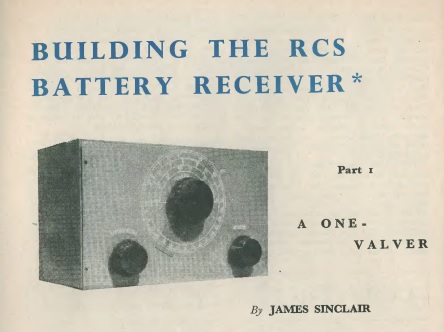 Seventy years ago this month, the July 1954 issue of the British publication Radio Constructor carried the plans for this one-tube regenerative receiver for the “veriest beginner” to radio. The magazine noted that such a beginner may not yet know how to read schematics, and the the magazine thus carried Heathkit-style step-by-step instructions for wiring it up.
Seventy years ago this month, the July 1954 issue of the British publication Radio Constructor carried the plans for this one-tube regenerative receiver for the “veriest beginner” to radio. The magazine noted that such a beginner may not yet know how to read schematics, and the the magazine thus carried Heathkit-style step-by-step instructions for wiring it up.
Future issues of the magazine would add improvements, which would ultimately result in a three-tube set.
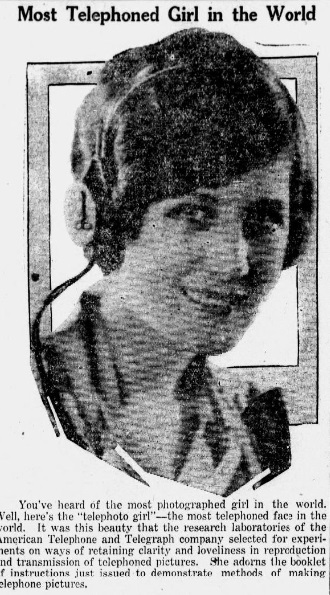 A hundred years ago today, this unnamed woman was named the “most telephoned girl in the world.” The title didn’t come from her receiving the most calls, but by her image being transported over phone lines. The July 22, 1924, issue of the New Britain (CT) Herald noted that it was “this beauty that the research laboratories of the American Telephone and Telegraph company selected for experiments on ways of retaining clarity and loveliness in reprodcution and transmission of telephoned pictures.” He picture was on the cover of the instruction booklet for the AT&T Telephotography service.
A hundred years ago today, this unnamed woman was named the “most telephoned girl in the world.” The title didn’t come from her receiving the most calls, but by her image being transported over phone lines. The July 22, 1924, issue of the New Britain (CT) Herald noted that it was “this beauty that the research laboratories of the American Telephone and Telegraph company selected for experiments on ways of retaining clarity and loveliness in reprodcution and transmission of telephoned pictures.” He picture was on the cover of the instruction booklet for the AT&T Telephotography service.
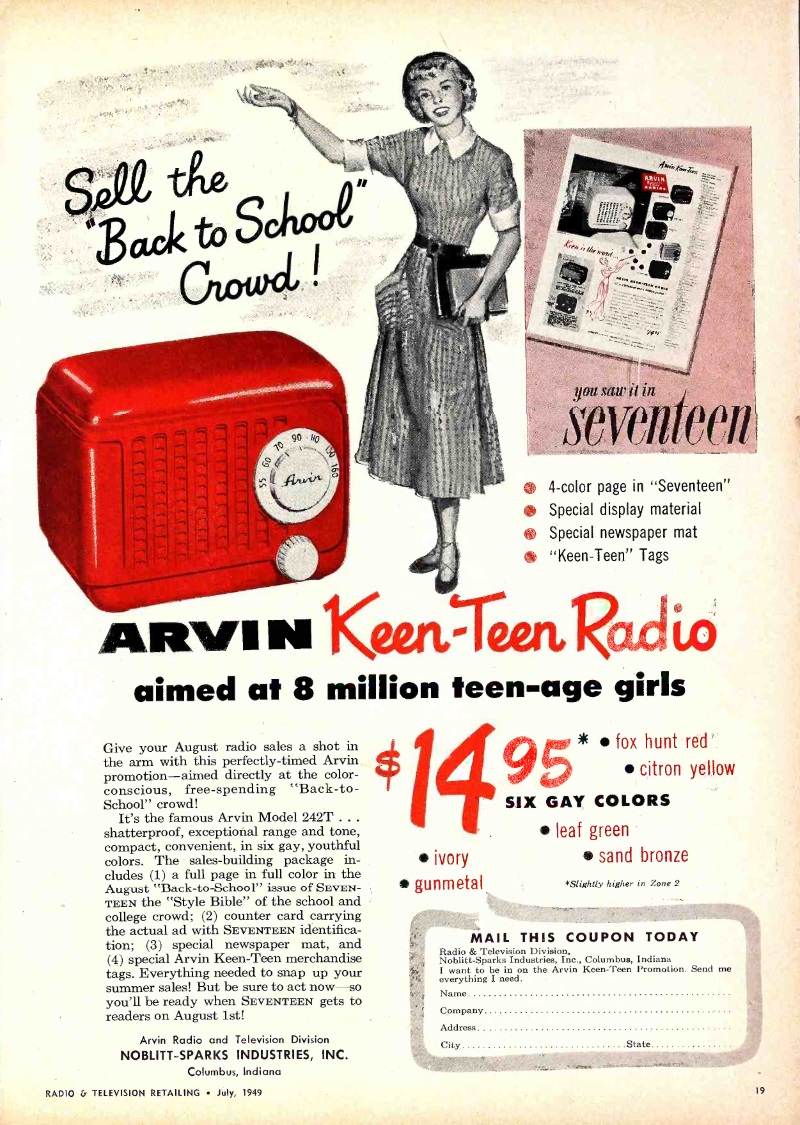 Seventy five years ago, this lucky young woman (now about 92 years old) was the new owner of her very own radio, the Arvin Model 242T “Keen-Teen” radio. It was aimed at the nation’s eight million teen girls, who saw it prominently advertised in the “Back to School” issue of Seventeen magazine.
Seventy five years ago, this lucky young woman (now about 92 years old) was the new owner of her very own radio, the Arvin Model 242T “Keen-Teen” radio. It was aimed at the nation’s eight million teen girls, who saw it prominently advertised in the “Back to School” issue of Seventeen magazine.
This ad, in the July 1949 issue of Radio & Television Retailing, reminded dealers that this issue of the magazine was the “Style Bible” of the school and college crowd. In addition to the magazine ad, there would be a point of sale display featuring the actual ad. They were urged to be ready when the magazine hit the newsstands on August 1. The four-tube set retailed for $14.95, which works out to $197 in 2024 dollars. But mom and dad probably cashed in a war bond, which was keen.
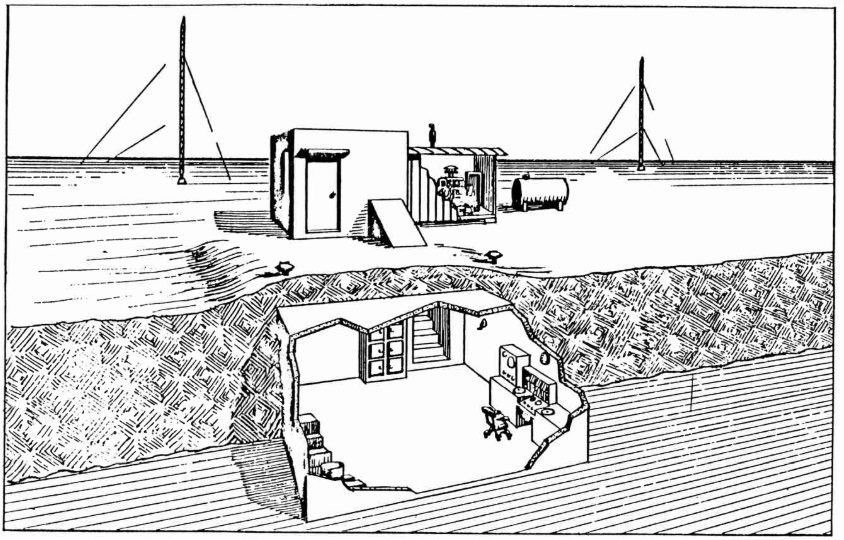 Shown here is some key station in the Emergency Broadcast System, after it was equipped to stay on the air after a nuclear attack. The diagram appears in a 1984 FEMA publication, Broadcast Station Protection Program, which outlined the program. Much of the hardening would be paid for by the government, such as construction of fallout shelters for station personnel, emergency generators, and remote pickup equipment to link the station back to the EOC.
Shown here is some key station in the Emergency Broadcast System, after it was equipped to stay on the air after a nuclear attack. The diagram appears in a 1984 FEMA publication, Broadcast Station Protection Program, which outlined the program. Much of the hardening would be paid for by the government, such as construction of fallout shelters for station personnel, emergency generators, and remote pickup equipment to link the station back to the EOC.
The cost of stocking the station with food and supplies for the staff was the responsibility of the station owner and licensee. Facilities were designed to be adequate, although austere.
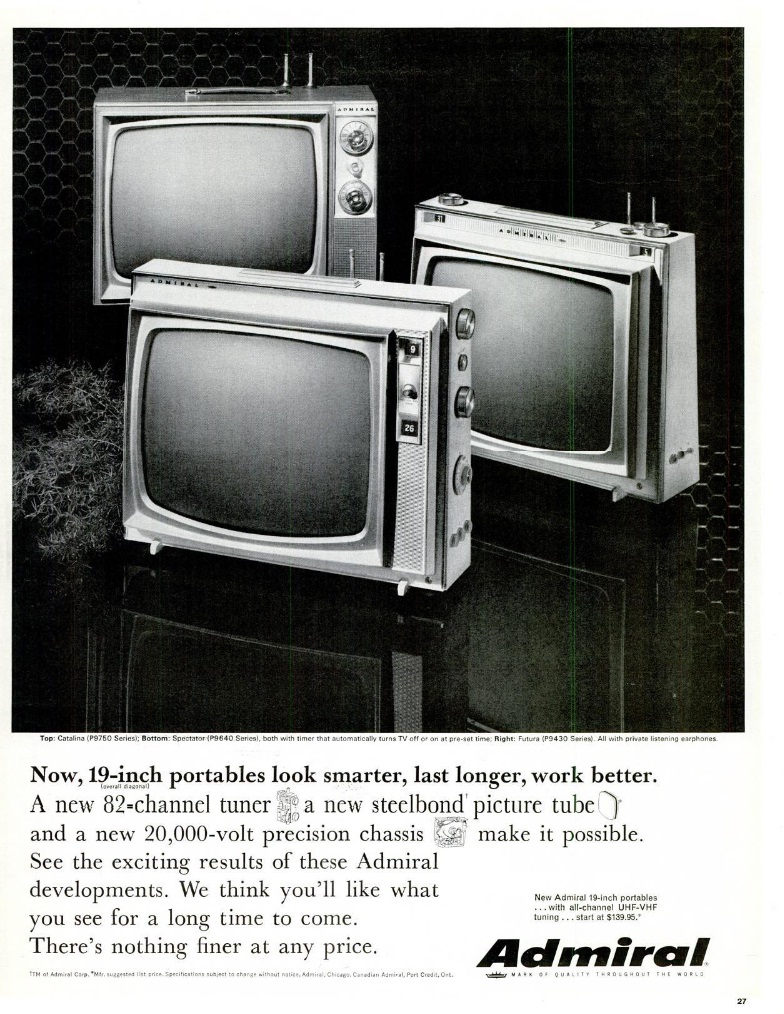 Sixty years ago today, the July 17, 1964 issue of Life Magazine carried this ad showing the 19-inch offerings of Admiral TV. Shown are the Catalina (P9750 Series), the Spectator (P9640 Series) and Futura (P9430 Series) models. All featured all-channel tuning (channels 2-83) and private listening earphones. The Catalina and Spectator featured timers to turn the set on or off at a pre-set time. All were “portable,” in that they could be moved from one place to another by one person. But they spent most of their time in the same place, near an electrical outlet of course.
Sixty years ago today, the July 17, 1964 issue of Life Magazine carried this ad showing the 19-inch offerings of Admiral TV. Shown are the Catalina (P9750 Series), the Spectator (P9640 Series) and Futura (P9430 Series) models. All featured all-channel tuning (channels 2-83) and private listening earphones. The Catalina and Spectator featured timers to turn the set on or off at a pre-set time. All were “portable,” in that they could be moved from one place to another by one person. But they spent most of their time in the same place, near an electrical outlet of course.
The set I watched as a child resembled the “Catalina,” although ours didn’t have the timer or the earphone.
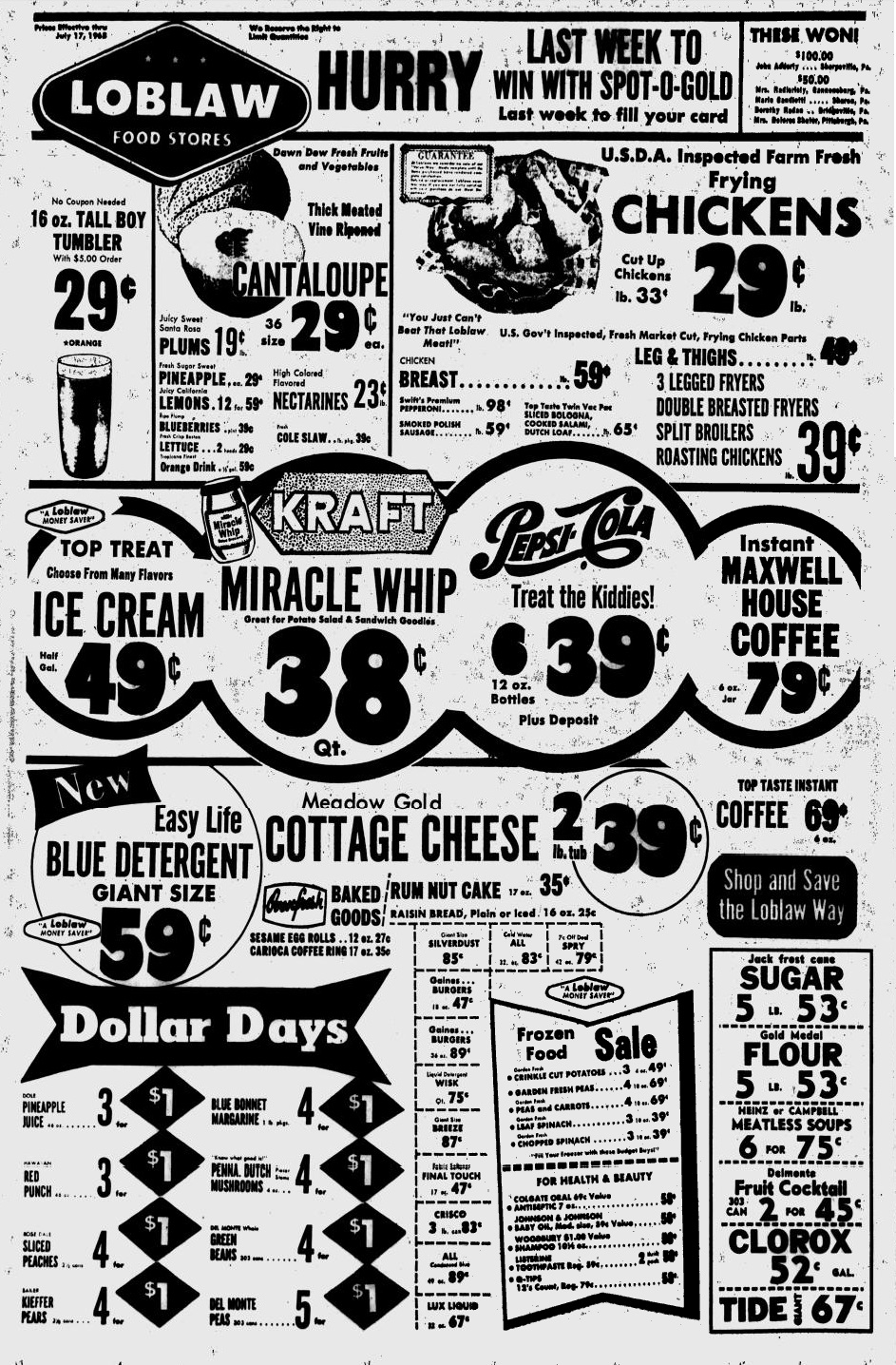 For a snapshot of grocery prices in 1965, this ad for Loblaw’s supermarket appeared in the Pittsburgh Post-Gazette on July 15, 1965.
For a snapshot of grocery prices in 1965, this ad for Loblaw’s supermarket appeared in the Pittsburgh Post-Gazette on July 15, 1965.
Chicken was 39 cents a pound, sugar was just over a dime a pound, and a six pack of Pepsi was only 39 cents, plus deposit.
Of course, there’s been a lot of inflation since then. According to this inflation calculator, you need to multiply those prices by about 10 to get the equivalent in 2024 dollars.
What would you buy for dinner in 1965?